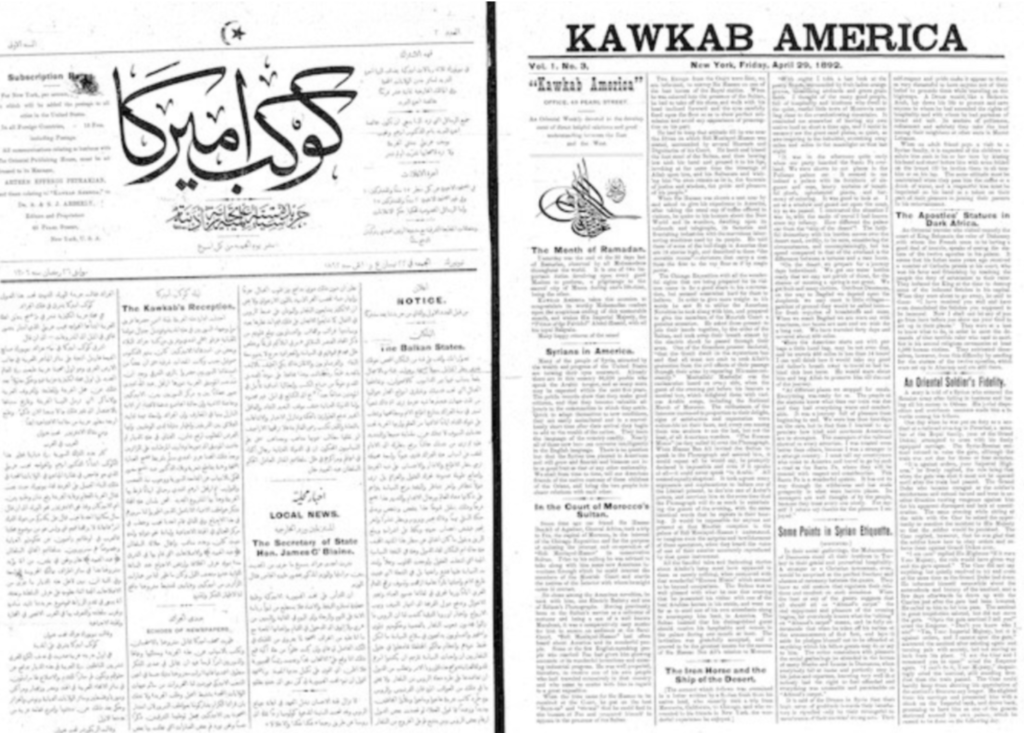“Kawkab America”: The First Arab American Newspaper

Photo Credit: Wiki Commons
By: Arwa Almasaari / Arab America Contributing Writer
Kawkab America is widely recognized as the first Arabic newspaper, founded by members of the Greek Orthodox Church (Mehdi 5, 7). What is less commonly known is that this groundbreaking publication was bilingual, non-sectarian, and transnational. Its efforts to forge connections and promote unity among diverse communities—overcoming geographical, linguistic, and religious barriers—are truly commendable.
The Arbeely brothers, Ibrahim (Abraham) and Najib (Nageeb), established Kawkab America in New York on April 15, 1892 (Durmaz 1-3). With an estimated circulation between 400 and 800 copies in 1894 in New York City alone, Kawkab had a significant impact on the Arab and Arab American communities (Jacobs 268).
A Transnational Vision
The first issue of Kawkab, published in 1892, described itself as “An Oriental Weekly devoted to the development of direct helpful relations and good understanding between the East and the West.” The newspaper catered to three distinct audiences in different locations: Ottoman residents, Arab Americans, and the broader American community. It was published in both Arabic and English to address issues relevant to all three groups, demonstrating its ambitious transnational goal.
The newspaper published in English and Arabic for a year before discontinuing its English edition to focus exclusively on its Arabic-speaking audience (Womack 34). Scholars speculate that the English sections targeted the broader American community, while the Arabic sections catered to the Arab diaspora, particularly the new immigrants in the US (Womack 30-4; Durmaz 7). However, in his autobiography A Far Journey, Abraham Rihbany, who worked as an editor at Kawkab America, mentioned that most of the newspaper’s subscribers were residents of the Ottoman state (240). He recalled one of the founders, Najib Arbeely, emphasizing their heavy reliance on Ottoman subscribers to the extent that if circulation were to stop in the Ottoman state, the “whole enterprise must cease to be” (240).
The newspaper’s launch was celebrated in both the U.S. and the Arab world (Rihbany 240). It received extensive coverage in U.S.-based newspapers and warm congratulations from teachers, poets, and religious leaders across Syria (240). The headquarters was filled with “a large group of Syrians” and American reporters (Rihbany 240). Najib Arbeely decorated the room with “Oriental draperies” and served the “happy guests” with beer and arak (240).
Orthodox Founders with a Secular Approach
Despite the founders’ Orthodox background, Kawkab published articles by members of various faiths (Womack 34). Abraham Rihbany listed five office staff members who helped in launching the newspaper: “Najib Arbeely, the proprietor, a Damascene; Hbib Patrekian, the publisher, an Armenian; Yusuf Hajj, the compositor, a Beyroutine; and myself” (231). The members not only came from different regional backgrounds but also had diverse religious affiliations. Although Rihbany does not mention their church affiliations, it is well known that the Arbeely brothers were Orthodox, and Rihbany had already converted to Protestantism by then (Rihbany 141). Rihbany mentions arguing with Arbeely about the newspaper’s support of the Ottoman state but never about religion. In fact, Rihbany claims that he quit working for Kawkab after a year due to the newspaper’s allegiance to the Ottoman state.
One of Kawkab‘s most notable aspects was its sympathetic coverage of minority issues. It reported on anti-Semitic riots in Poland (Durmaz 11) and Chinese immigrants’ efforts to challenge Congress’s denial of citizenship (Matar 13). In the few times that Jews were mentioned in the articles, they were described as a successful, devout, and well-established community (Durmaz 11). The newspaper also highlighted the plight of Native Americans, criticizing American narratives that glorified Columbus Day while overlooking the atrocities committed against indigenous peoples (Matar 16).
Orientalism and the Contradictions
According to Linda Jacobs, Najib participated in various world fairs. Pictures show him performing at one of the fairs with his brothers. All the pictures depict them performing in a stereotypical Orientalist manner. One picture, in particular, caught my attention as it showed them pretending to perform the Muslim prayer, but only one was shown with a correct posture. Additionally, Abraham Rihbany engaged with Orientalist rhetoric to establish himself as an exemplary American citizen (Almasaari 92).
Therefore, it is interesting to see that Kawkab offered a counter-narrative to “Oriental tales” that were often reported in American periodicals (Peckham and Majaj 14). The English sections of Kawkab tried to address the ” hostility, stereotyping, and cynicism” that dominated narratives of the Orient (Peckham and Majaj 14). They also offered a counter-narrative to the misrepresentation of the Arab world by missionaries and travelers (Womack 34).
The Legacy
Kawkab America should be celebrated for being the first of its kind and for its efforts to unite the community, regardless of their backgrounds. Its bilingual and non-sectarian approach, along with its commitment to addressing minority issues and countering Orientalist narratives, marked it as a pioneering publication. Despite its eventual focus solely on Arabic-speaking audiences, the newspaper’s legacy in illustrating the complexities of Arab identities and fostering transnational connections remains noteworthy.
References:
Almasaari, Arwa. From Scriptures to Stereotypes: Arab Americans Writing Self. 2024. University of Wisconsin Milwaukee, Doctoral dissertation.
Durmaz, Reyhan. “Religion, Race, and Letterpress: Orthodox Christians in Nineteenth-Century New York City through the Lens of Kawkab America.” Journal of the American Academy of Religion, 2024, pp. 1-21. https://doi.org/10.1093/jaarel/lfae027.
Jacobs, Linda K. “An Arbeely Family Album.” ArcGIS StoryMaps, 29 Sept. 2021, https://storymaps.arcgis.com/stories/6077c56c184e4ec8b898f6486c8e977c. Accessed 24 July 2024.
Jacobs, Linda K. Strangers in the West: The Syrian Colony of New York City, 1880-1900. Kalimah Press, 2015.
Matar, Nabil. United States Through Arab Eyes: An Anthology of Writings (1876-1914). Edinburgh University Press, 2018.
Mehdi, Beverlee Turner. The Arabs in America, 1492-1977. Oceana Publications, 1978.
Peckham, Susan Atefat, and Lisa Suhair Majaj, editors. Talking through the Door: An Anthology of Contemporary Middle Eastern American Writing. Syracuse University Press, 2014.
Rihbany, Abraham Mitrie. A Far Journey. Houghton Mifflin Company, 1914.
Womack, Deanna Ferree. “Syrian Christians and Arab-Islamic Identity: Expressions of Belonging in the Ottoman Empire and America.” Studies in World Christianity, vol. 25, no. 1, Apr. 2019, pp. 29–49. https://doi.org/10.3366/swc.2019.0240.
Arwa Almasaari is a scholar, writer, and editor with a Ph.D. in English, specializing in Arab American studies. She often writes about inspirational figures, children’s literature, and celebrating diversity. You can contact her at arwa_phd@outlook.com
Check out our blog here!








